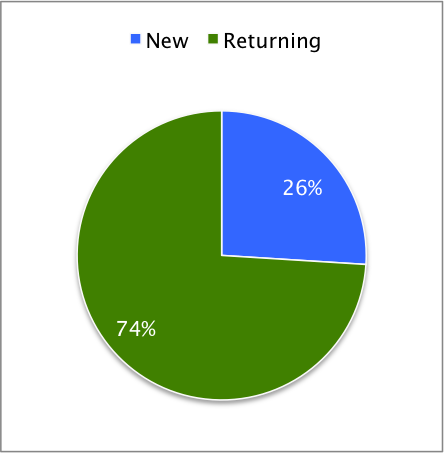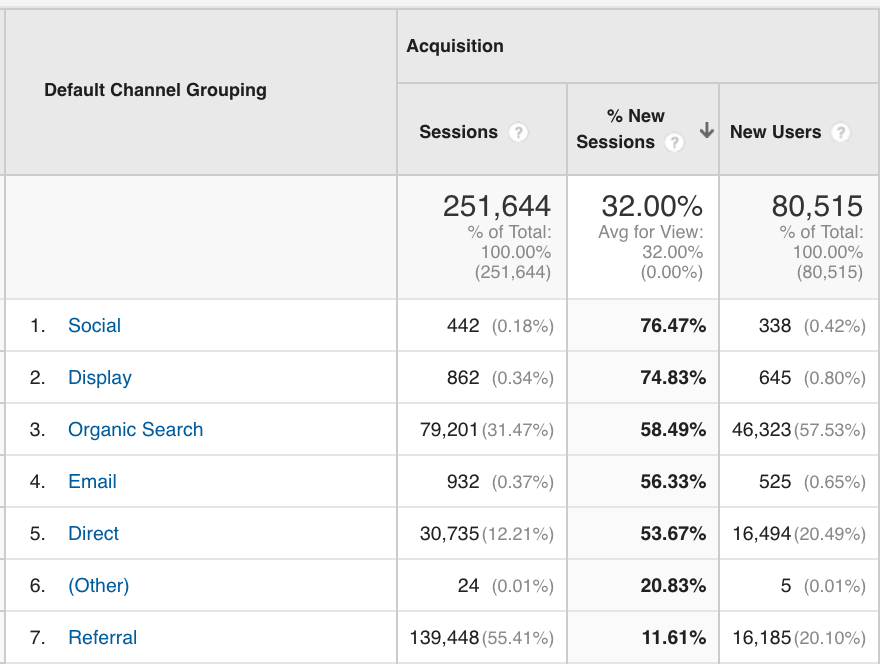New vs. Returning Visitor Insights
I received a fantastic question from a client this week. The question was:
“Do you have an opinion regarding our New vs. Returning visitor ratio for external visits? It’s currently 74% Returning, 26% New.

“I know the ratios will differ based on the type of site, business, etc, but I’m interested in learning what a good ratio might be for our company.”
To answer this question I have to first be mindful of the goals of each marketing initiative. Is the marketing working to bring in new visitors? Bring in returning visitors? What kind of visitor do I expect to see from each marketing channel and tactic?
Here is what I would expect to see from each marketing channel when analyzing the ration of New vs. Returning visitors.
Channel and Tactic Expectations
In general, without looking at specific metrics, I’d say this:
- Social media is commonly used to attract the attention of a larger audience or to engage an existing one. As an organization’s social media strategies become more advanced, there tends to be more engagement with their established audience and, therefore, a rise in the amount of returning visitors to the company’s website.
- Displayadvertising is most commonly meant to bring in new visitors Most clients use display advertising to find relevant new audience members on targeted websites with awareness ads. I’d expect to see mostly new visits from display, and I’d expect the quantity to be larger than social, but not by too much (depending on each clients display advertising budget).
- Organicsearch should be pretty even. My clients want to attract both new and returning visitors from organic search. I’d also expect this to be the largest driver of overall traffic, evening out the pie chart as much as possible.
- Email – From what I know of this particular client’s emailefforts, I’d expect that to be mostly returning visitors. I’d also expect the quantity to be small. However, each client’s email efforts will be different, so the quantity will vary as well as the visitor type. If the list comes from the company Customer Relationship Management system (CRM), I’d expect to see mostly returning visitors. If the email list is a purchased list of prospects, I’d expect to see more new visitors than returning.
- Directtraffic should be returning visitors, and I’d expect that to be the 2nd largest source after Organic search.
- Referral Traffic – I’d expect some new visits from referringlinks, but in order to get really good data from referral sources, we usually need to apply a lot of filters. I’d also expect that without these filters being applied, large quantities of sessions are being attributed to the referral medium. So after we look at the analytics, we’ll drill down to see if the referral source needs to be cleaned to get better data.
Channel and Tactic Metrics
Now that we’ve stated our expectations for each marketing channel, let’s open Google Analytics and see if data supports our hypothesis.
Here’s what we see in Analytics for this client since the beginning of the year:

This is exactly what I’d expect to see.
Now that we’ve seen an overview of all marketing channels, next, drill into the Referral source. Since it’s a very large number of sessions, it will greatly affect the grand total of new vs. returning percentage of visitors. Known spam referral sources were found in this unfiltered data.
Once you’ve edited your custom segment to remove spam referral traffic, you should be able to get a better idea of the visitor type that is coming through from websites that link to yours.
Here’s the actual break down of new vs. returning visitors to this client’s website.

So while I can’t quite give a benchmark for what the ratio should be in your industry, we can definitely analyze the data to see if each marketing initiative is bringing in the type of visitor, and the quantity of visits, that your company expects.
I’ll add that we, as marketers, can change the balance of this pie chart. We’re very much in control of this. If our directors tell us that the goal for Q4 is to see the biggest increase in the amount of new customers, we can design a marketing strategy that will cause an increase in new visits to the site.
If our directors tell us that the goal for Q4 is to retain customers and drive deeper adoption, we can design a marketing strategy that will cause an increase in returning visitors.
If the directors tell us both, we shouldn’t look at the percentage metric, but rather the session count and look for an overall increase.
Thanks to my outstanding clients who ask great questions like this. If you have a question about gaining deeper insights from your Google Analytics, please don’t hesitate to get in contact with us.
Featured Image Ciation: Flickr Creative Commons – Nosha “Dormant”